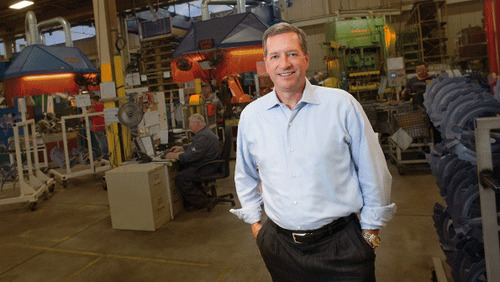Nov 7 2012
John Shook: Lean Management Success Depends on a Problem-Solving Culture
See on Scoop.it – lean manufacturing
But problem solving is a problem at companies accustomed to hiding problems, according to Shook.Cambridge, MA (PRWEB) November 05, 2012 A company’s “attitude towards problems” determines if it succeeds or fails at a lean management transformation,…
See on news.yahoo.com

 See on
See on 
Nov 18 2012
Why 5S fails
In the Lean CEO discussion group on LinkedIn, Paul Renoir started a discussion on why 5S implementations are not sustained. As one of the participants, Sammy Obara, pointed out, if it’s not sustained, by definition it’s not 5S. The discussion is really about why 5S fails, and failing it does, massively and systematically. Among the 22 contributions to this discussion to date, there isn’t a single one contradicting its basic premise, and asserting what a great success 5S has been in specific facilities.
What I have written on 5S in this blog before may make me sound as if I thought of it as worthless. It’s not the case. 5S is a valuable tool, and it is implemented with success in many factories in Japan. The failures that can be seen in the US and Europe are due to misunderstandings, translation errors, and wrong decisions as to when and why it should be implemented. My previous posts on the subjects are as follows:
Why consultants recommend starting with 5S
Consultants often recommend that a company start with 5S for the wrong reasons. One quick look at a plant and you know that it would be better with 5S, but that doesn’t mean that 5S would solve its problems or that the organization is capable of implementing it.
It’s like a kid with problems at school who has a messy room. It’s easy to tell the kid to tidy up the room, but it won’t solve the problems at school, and it won’t be sustained. Whether with a plant or a kid, figuring out what the problems are takes more time and effort, but it is necessary if you want to identify projects (1) that put the organization on track to a solution, (2) that it has the skills and the will to conduct successfully, and (3) that entail changes that will be sustained.
Initial projects that work
Art Byrne, among others, recommend giving stretch goals to projects. The point of stretch goals is that they cannot be reached just by putting in extra effort temporarily. Instead, stretch goals require you to make substantial, physical changes to the work, including modifications of machines or fixtures. Once you have made such changes, not only do you achieve your stretch goals, but you don’t easily revert to the old way. In the initial stages of Lean implementation, the only way you get any 5S to stick is by making it the “finishing touches” on other projects, like cells or SMED. If, instead, 5S is the project, it won’t be sustainable.
5S and involvement by everyone
One aspect of 5S that is lacking in just about every discussion of it that I have seen in English is that, when you make 5S a project on its own, it must involve everyone. Participation is not on a voluntary basis. Everyone from the CEO to the janitor must participate, and it fails unless this actually happens. Most employees consider this cleaning up to be beneath them, and top managers’ direct participation is essential to prevent them from feeling this way and acting accordingly.
This is why 5S is so difficult to implement, especially as your first step towards Lean. On the other hand, if you have taken the content of 5S and, as I suggested before, made it part of such other projects as cells or SMED, you may have, after a year or two, about 20% of your work force unknowingly practicing 5S. At that point, you may choose to make 5S your next project and leverage this 20% to achieve 100% involvement. Then you a have a chance to make it stick.
There are other features of Lean that require participation by everyone, particularly autonomous maintenance, which is the only aspect of TPM that you see widely implemented. Somewhere along your Lean journey, you have to learn how to implement practices that require participation by everyone, which is what, in Japan, is meant by “Total.”
5S is a good choice for your first “Total” program and, in particular, works as a stepping stone to TPM. Once you have your 5S daily routine in place, it is a natural transition to enhance it to include checks on the vital signs of your equipment.
Translation errors about 5S
If 5S efforts were broadly successful, there would be no point in raising an issue. Since, however, they are almost universal failures, it might help to communicate accurately on what 5S actually means.
I first learned about “4S” in Japan in the 1980s, from my mentor Kei Abe, and studied it in the Japanese literature. As the time, it was translated into English as R.I.C.K., for Remove, Identify, Clean, and Keep clean, and I thought it was a reasonable approximation. A few years later, my colleague Crispin Vincenti-Brown introduced me to a major American corporation with plants that bore the traces of a failed 5S implementations, from fading banners on the walls to obsolete markings and dirty work stations. Three years before, the top management had been on a tour of Japan, had seen 5S in action there, and had committed to implement it, going as far as putting a Vice President in charge of it. And this was the result. The operators’ version of the meaning of 5S was “Some Stupid Supervisor Said So.”
By then, it was no longer 4S but 5S, and someone had seen fit to translate the five Japanese words with English words that also started with S. While it was undoubtedly clever, the meaning of these five words just didn’t match the original, and these mistranslations, frequently repeated, now have become some sort of standard.
Following are explanations of the original five S’s, to the best of my ability:
Share this:
Like this:
By Michel Baudin • Policies 6 • Tags: 5S, Kaizen, Lean, Lean implementation, Stretch goal, TPM